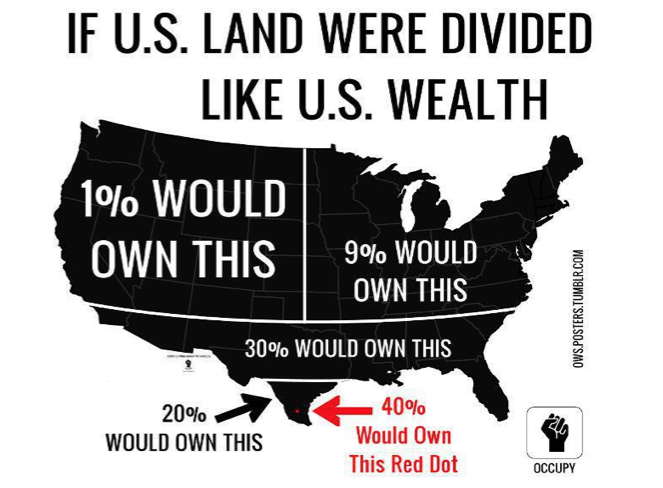CommentsSPIKING INCOME INEQUALITY-Despite the upbeat words from America’s billionaire president about the “economic miracle” he has produced, economic inequality in the United States is on the rise.
In August 2019, the Economic Policy Institute reported that, in 2018, the average pay of CEOs at America’s 350 top firms hit $17.2 million―an increase, when adjusted for inflation, of 1,007.5 percent since 1978. By contrast, the typical worker’s wage, adjusted for inflation, grew by only 11.9 percent over this 40-year period. In 1965, the ratio of CEO-to-worker’s pay stood at 20-to-1; by 2018 (when CEOs received another hefty pay raise and workers received a 0.2 percent pay cut), it had reached 278-to-1.
An AFL-CIO study, released in June 2019, had similar findings. Examining compensation at Standard & Poors 500 companies, the labor federation reported that average CEO pay in 2018 had increased by $5.2 million over the preceding 10 years. This resulted in an average CEO-to-worker pay ratio of 287-to-1.
These figures, of course, are only averages, and at numerous major corporations, the economic gap between boss and worker is much greater. According to the AFL-CIO, the CEO-to-worker pay ratio at Walmart (America’s largest private employer) is 1,076 to 1, at Walt Disney Company 1,424-to-1, at McDonald’s 2,124-to-1, and at Gap 3,566-to-1. At 49 S&P 500 firms, noted an Institute for Policy Studies report, half the work force―that is, 3.7 million employees―received wages below the official U.S. poverty line for a family of four.
Thus, despite the soaring incomes of top corporate executives and other wealthy Americans, the median household income in the United States grew by only 0.2 percent during 2018―a decline from the three previous years. Commenting on U.S. wage stagnation, Sam Pizzigati, co-editor of inequality.org, observed that “average Americans have spent this entire century on a treadmill getting nowhere fast. The nation’s median―most typical―households pocketed 2.3 percent fewer real dollars in 2018 than they earned in 2000.”
Although President Donald Trump has claimed that “inequality is down,” federal data released this year show that, in 2018, the nation’s income inequality reached the highest level since the U.S. Census Bureau began measuring it five decades before.
U.S. economic inequality is even greater in terms of wealth. uring the Democratic presidential debate in late June 2019, Senator Bernie Sanders reminded Americans that just three U.S. billionaires (Jeff Bezos, Bill Gates, and Warren Buffett) possessed as much wealth as half the people in the United States combined. And the three richest U.S. families―the Waltons (owners of Walmart), the Mars candy family, and the Koch family (owners of a vast fossil fuel conglomerate)―possessed a combined fortune ($348.7 billion), which is 4 million times the wealth of the median U.S. family.
Although the median net worth of U.S. households has declined (after adjusting for inflation) since the late 1990s, the fortunes of the wealthy have skyrocketed. The American billionaires sharing their ostensible wisdom at the World Economic Forum in Davos at the beginning of 2019 made enormous gains in wealth over the previous decade. They included Jamie Dimon (275 percent), Rupert Murdoch (472 percent), Stephen Schwarzman (486 percent), Marc Benioff (823 percent), and Mark Zuckerberg (1,853 percent).
According to computations made by Forbes in October 2019, the ten wealthiest Americans (with riches ranging from $53 billion to $107.5 billion each) had combined wealth of $697 billion―or an average of $69.7 billion each. Assuming that, henceforth, they had no further income and had limitless longevity, they could each spend a million dollars a day for approximately 191 years.
Most other Americans possess far fewer economic resources. In 2018, 38.1 million Americans lived below the U.S. government’s official poverty threshold, including many people working at multiple jobs. Furthermore, another 93.6 million Americans lived close to poverty, bringing the total of impoverished and near-impoverished people to nearly 42 percent of the U.S. population.
Naturally, economic deprivation has serious consequences. According to the U.S. Department of Agriculture, 14.3 million households in America have difficulty providing enough food for their families. Low-income families are also plagued by inadequate education, alcohol and substance abuse, and poor housing, health, and life expectancy.
The U.S. Government Accountability Office reported in September 2019 that poor Americans die at an earlier age than rich ones. Indeed, in 2019, for the first time in a century, life expectancy in the United States declined for three consecutive years. Suicide rates, which closely correlate with poverty, increased by 33 percent since 1999. Even what is left of the dwindling middle class faces the crippling costs of health care, college education, and debt payments.
This situation bears no resemblance to that of America’s ultra-wealthy, who, in addition to pouring money into the campaign coffers of politicians that safeguard and expand their fortunes, continue purchases like one multi-billionaire’s acquisition of a $238 million Manhattan penthouse―a supplement to his two floors at the Waldorf Astoria hotel in Chicago ($30 million), Miami Beach penthouse ($60 million), Chicago penthouse ($59 million), and additional apartment in Manhattan ($40 million). Other recent purchases by the ultra-rich include a $100 million, 305-foot “super-yacht” (complete with helipad and IMAX theater), private jet planes ($65 million), and (of course) gold toilet paper.
The latest attraction for America’s ultra-affluent is Manhattan’s 131-floor Central Park Tower building which, when completed, will become the tallest, most expensive residential dwelling in the United States. It will feature 179 luxury condos ranging in price from $6.9 million to $95 million and a seven-story Nordstrom flagship store with six restaurants, plus three floors of “amenity space” (dubbed the Central Park Club) spanning 50,000 square feet, with an outdoor terrace, pools, a wellness center, and a massive ballroom. The immense height of the structure will underscore the vast power of the super-rich, as well as enable them to avoid noticing the many “losers” left behind on the teeming streets below.
(Dr. Lawrence Wittner is Professor of History Emeritus at SUNY/Albany and the author of “Confronting the Bomb” (Stanford University Press). This piece first appeared on HistoryNewsNetwork.org. ) Prepped for CityWatch by Linda Abrams.
















